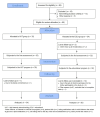High-intensity interval training is an effective exercise mode to maintain normal blood pressure during pregnancy: a randomized control trial
- PMID: 39543304
- PMCID: PMC11564664
- DOI: 10.1038/s41598-024-79552-3
High-intensity interval training is an effective exercise mode to maintain normal blood pressure during pregnancy: a randomized control trial
Abstract
Pregnant women are more susceptible to high blood pressure (BP) than the general adult population; therefore, all means of preventing this condition should be considered. High-intensity interval training (HIIT) is effective in this regard in the general population, but there is a lack of evidence of its effectiveness during pregnancy. This study aimed to compare an 8-week HIIT program to self-performed moderate-to-vigorous physical activity among pregnant women by evaluating changes in BP after a maximal progressive cardiorespiratory exercise test (CPET) performed at pre-intervention and post-intervention time points. A total of 54 Caucasian women in uncomplicated, singleton pregnancies (age 32 ± 4 years, 22 ± 4 weeks of gestation; M ± SD) with normal BP values completed the interventions. The experimental (HIIT) group (n = 34) completed an online supervised HIIT program consisting of three sessions per week and supplemented by an educational class once per week. Participants in the education (EDU) group (n = 20) attended an educational class once per week and were encouraged to perform moderate-to-vigorous physical activity (PA) on their own. Pre- and post-intervention, all women underwent a CPET on a cycle ergometer with a respiratory gas analyzer. On the day of the CPET, maternal systolic and diastolic BP (mmHg) was measured at rest (before the CPET) and approximately 60 min after the CPET using an electronic BP monitor. Identical CPET and BP measurement protocols were employed for both the HIIT and EDU groups at the pre- and post-intervention time points. Pre-intervention, the HIIT and EDU groups both showed a decrease in systolic and diastolic BP after the CPET, though only the change in systolic BP was statistically significant (HIIT group: p = 0.01; EDU group: p = 0.001). Post-intervention, there were no significant differences in either group between resting and post-CPET BP. There were significant post-intervention differences in VO2peak (p < 0.001) and HRmax (p = 0.002) between the HIIT and EDU groups. From pre- to post-intervention, the EDU and HIIT groups both showed decreases in resting systolic or diastolic BP; there was a significant difference in systolic BP in the EDU group (p = 0.005) and a significant difference in diastolic BP in the HIIT group (p = 0.03). Both groups maintained normal BP values throughout the experiment. However, HIIT, in addition to maintaining normotension, improved cardiorespiratory fitness in pregnant women. It seems that both supervised HIIT and self-performed moderate-to-vigorous PA can be recommended as strategies to prevent BP disorders during pregnancy. More studies are needed to confirm our findings.Trial registration The full study protocol was registered in ClinicalTrials.gov (NCT05009433).
Keywords: Blood pressure; Cardiopulmonary fitness; Exercise; HIIT; Pregnancy.
© 2024. The Author(s).
Conflict of interest statement
Figures





Similar articles
-
Can we hit prenatal depression and anxiety through HIIT? The effectiveness of online high intensity interval training in pregnant women during the COVID-19 pandemic: a randomized controlled trial.BMC Sports Sci Med Rehabil. 2022 Dec 22;14(1):215. doi: 10.1186/s13102-022-00610-2. BMC Sports Sci Med Rehabil. 2022. PMID: 36550564 Free PMC article.
-
Effects of high-intensity interval training compared to moderate-intensity continuous training on maximal oxygen consumption and blood pressure in healthy men: A randomized controlled trial.Biomedica. 2019 Sep 1;39(3):524-536. doi: 10.7705/biomedica.4451. Biomedica. 2019. PMID: 31584766 Free PMC article. Clinical Trial.
-
A Comparative Study of Health Efficacy Indicators in Subjects with T2DM Applying Power Cycling to 12 Weeks of Low-Volume High-Intensity Interval Training and Moderate-Intensity Continuous Training.J Diabetes Res. 2022 Jan 13;2022:9273830. doi: 10.1155/2022/9273830. eCollection 2022. J Diabetes Res. 2022. PMID: 35071605 Free PMC article. Clinical Trial.
-
The effect of high Intensity interval training versus moderate intensity continuous training on arterial stiffness and 24h blood pressure responses: A systematic review and meta-analysis.J Sci Med Sport. 2019 Apr;22(4):385-391. doi: 10.1016/j.jsams.2018.09.228. Epub 2018 Sep 22. J Sci Med Sport. 2019. PMID: 30803498
-
The impact of sprint interval training versus moderate intensity continuous training on blood pressure and cardiorespiratory health in adults: a systematic review and meta-analysis.PeerJ. 2024 Mar 14;12:e17064. doi: 10.7717/peerj.17064. eCollection 2024. PeerJ. 2024. PMID: 38495758 Free PMC article.
References
-
- Weissgerber, T. L. & Wolfe, L. A. Physiological adaptation in early human pregnancy: Adaptation to balance maternal-fetal demands. Appl. Physiol. Nutr. Metab.31, 1–11 (2006). - PubMed
-
- Gregg, V. H. & Ferguson, J. E. Exercise in pregnancy. Clin. Sports Med.36, 741–752 (2017). - PubMed
-
- Eshriqui, I. et al. Gestational dietary patterns are not associated with blood pressure changes during pregnancy and early postpartum in a Brazilian prospective cohort. Eur. J. Nutr.55, 21–32 (2016). - PubMed
-
- Hermida, R. C., Ayala, D. E. & Iglesias, M. Predictable blood pressure variability in healthy and complicated pregnancies. Hypertension. 38, 736–741 (2001). - PubMed
Publication types
MeSH terms
Associated data
Grants and funding
LinkOut - more resources
Full Text Sources
Medical

